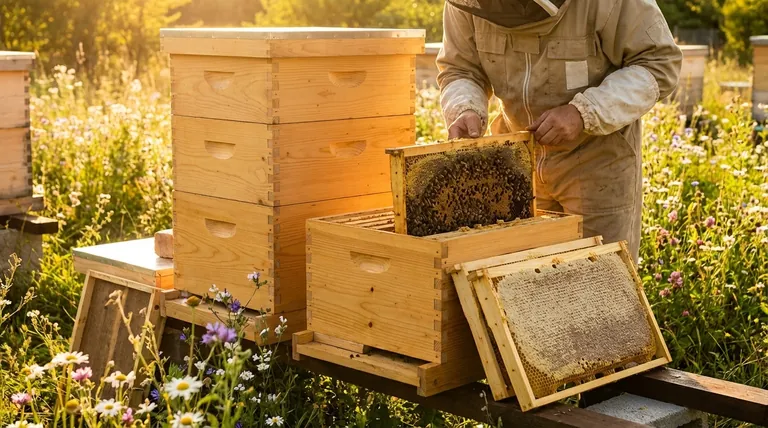In short, the deep hive body is normally used for brood because it becomes dangerously heavy when full of honey. A standard 10-frame deep box filled with honey can weigh between 80 and 100 pounds, making it impractical and unsafe for a single person to lift during routine inspections or honey harvesting.
The core principle of modern beekeeping is balancing the natural needs of the honeybee colony with the physical limitations of the beekeeper. Using deep boxes for the brood nest and shallower boxes for honey is the standard method for achieving this balance effectively.

The Role of the Hive Body (Brood Chamber)
The Colony's Living Quarters
The deep hive body, also called the brood chamber or brood box, is the heart of the colony. It sits at the bottom of the hive stack and serves as the primary living space.
This is where the queen bee lives and lays her eggs. It is also where worker bees raise the young larvae and pupae, collectively known as brood.
A Pantry for the Bees
In addition to brood, the bees use the deep hive body as their main pantry. They store significant amounts of pollen and honey in these frames to feed themselves and the developing brood, especially to survive the winter.
Sizing for the Queen's Domain
The standard deep hive body is 9-½ inches tall, making it the largest component of a typical Langstroth hive. This large, uninterrupted space allows a productive queen to establish a strong laying pattern, which is crucial for building a populous and healthy colony.
The Practical Problem of Weight
Why a Full Deep is So Heavy
Honey is incredibly dense. A single deep frame fully drawn out and filled with capped honey can weigh 8 to 10 pounds.
When you multiply that by the ten frames in a standard box, the total weight quickly reaches a level that is difficult for most people to manage safely.
The Impact on Beekeeping Tasks
This extreme weight makes essential beekeeping tasks nearly impossible. Routine hive inspections require lifting boxes to check the health of the brood chamber below.
Attempting to lift an 80+ pound box puts immense strain on your back and increases the risk of dropping the box, which can kill bees, damage equipment, and anger the colony.
The Solution: Honey Supers
To solve this problem, beekeepers use shallower boxes called "supers" for honey collection. These are placed on top of the deep brood box.
Medium supers (6-5/8” tall) or shallow supers (5-7/8” tall) hold less honey per box, resulting in a much more manageable weight of around 40-50 pounds when full. This allows the beekeeper to harvest honey one manageable box at a time.
Understanding the Trade-offs
Advantage: A Strong Brood Nest
The main benefit of using a deep box for brood is that it provides a large, contiguous area for the queen. This encourages a solid brood pattern and a very strong worker population, which is essential for a productive colony.
Disadvantage: Lack of Interchangeability
The primary trade-off is that you are managing two different box sizes. Frames from your deep brood box cannot be moved into your medium honey supers. This requires you to maintain two separate inventories of boxes and frames.
Alternative: The All-Medium Hive
Some beekeepers with back problems or a desire for simplicity choose to run their hives using all medium-depth boxes for both brood and honey. While this requires more boxes to equal the space of a deep, every component is lighter and completely interchangeable.
Making the Right Choice for Your Goal
Structuring your hive correctly from the start prevents logistical headaches and physical strain later on.
- If your primary focus is a traditional, robust hive: Use one or two deep boxes for the brood chamber and medium boxes for your honey supers.
- If your primary focus is a lightweight, uniform system: Use all medium boxes for both brood and honey, accepting you will need more boxes overall.
- If your primary focus is minimizing heavy lifting above all else: Use shallow supers for honey, as they are the lightest option when full.
Ultimately, designing your hive setup around these principles creates a system that is productive for your bees and manageable for you.
Summary Table:
| Hive Box Type | Common Use | Full Weight (Approx.) | Key Consideration |
|---|---|---|---|
| Deep (9-½") | Brood Chamber | 80-100 lbs | Too heavy for safe lifting when full of honey. |
| Medium (6-5/8") | Honey Super | 40-50 lbs | Manageable weight; popular for honey harvesting. |
| Shallow (5-7/8") | Honey Super | 30-40 lbs | Lightest option; ideal for minimizing strain. |
Ready to build a productive and manageable apiary?
At HONESTBEE, we supply commercial apiaries and beekeeping equipment distributors with the high-quality, durable hive bodies and supers needed to implement these best practices. Whether you prefer a traditional deep-and-medium setup or a streamlined all-medium system, we have the wholesale-focused inventory to support your operation's growth and efficiency.
Let's discuss your specific needs. Contact our team today for wholesale pricing and expert advice.
Visual Guide

Related Products
- Australian Langstroth Beehive Boxes for Beekeeping Wholesales
- Langstroth Bee Hives Bee Keeping Box for Beginners Beekeeping
- Langstroth Honey Bee Box Hive Boxes for Different Depths
- HONESTBEE Professional Long Handled Hive Tool with Precision Cutting Blade
- Professional Insulated Plastic Bee Hives
People Also Ask
- How many deep hive bodies should I use? The Standard for a Healthy, Winter-Ready Colony
- What are the sizes of supers available in a standard hive? A Guide to Deep, Medium, and Shallow Boxes
- What are the three types of beehives? Find the Perfect Hive for Your Beekeeping Philosophy
- What other types of hives are available besides the Flow Hive? Explore Langstroth, Top Bar, and Warre
- What is the best hive for beginners? A Guide to Langstroth, Top Bar, and Flow Hives



















